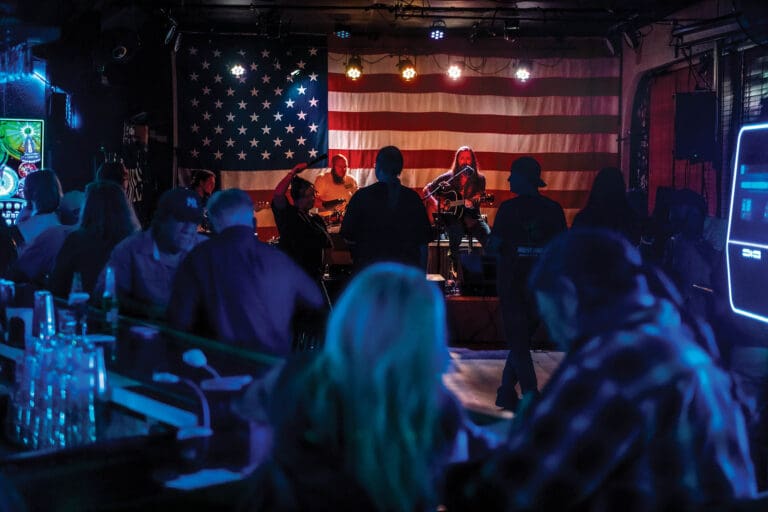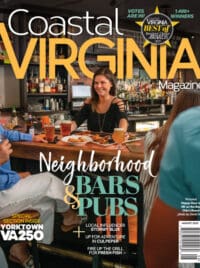Sean is crazy for LEGOs.
The 7-year-old is among the first to arrive at the Hampton Public Library's LEGO Club meeting, held every fourth Saturday of the month. Sitting with his mom at one of seven long tables, each adorned with two or three shoebox-sized containers of LEGO parts, he looks like he's about to burst out of his skin in anticipation. "He started off with the big LEGOs when he was a baby," his mother says with the resigned patience of someone who deals daily with a whirling dervish.
Hampton's monthly foray into mini-construction began in 2011, but the LEGO Club has never been more popular than now, says Eric Wilson, the children's librarian. Often the meeting room is filled to capacity with dozens of participants. Wilson monitors the proceedings, which normally have a suggested theme for building (today, it's winter) that the kids—ages 6 to 12—can either explore or ignore.
The word LEGO gets its name from a Danish phrase that translates to "play well." The interlocking plastic blocks—tricked out with different gears, characters and adaptable accessories—were developed in Denmark in the late ’40s and have shown real staying power, charming generations of children (and adults) worldwide. Today, the LEGO brand encompasses retail outlets, games, amusement parks, major building competitions and blockbuster movies (such as 2014's The LEGO Movie and this year's The Batman LEGO Movie).
"The movies have something to do with the appeal," Wilson says. "But also the fact that LEGOs have been around such a long period of time. The parents used to do it, and they pass it along to their kids."
Sean grins like the Cheshire Cat when Wilson announces that it’s time for everyone to open the boxes and dig in. "OK, let's see," he says, pouring the pieces onto the table. Why does he like LEGOs? "Because you can build whatever you want," he says as he selects his tools. "My dad grew up with LEGOs."
He swiftly snaps random pieces into place, but often stops and contemplates the more mysterious blocks. "What are these?" he asks about some silver objects. Eventually, they become ornaments for a sleek spaceship (with wheels), and a separate storage area powered by a windmill.

LEGOs are often endorsed as an educational tool by teachers and parents because they perfectly fit with the STEM—Science, Technology, Engineering and Math— approach to learning (sometimes an arts component is added to make it a STEAM program). LEGOs teach preschoolers important spatial reasoning skills, educators say, and help to hone math, history, language, writing and geography proficiency in developing kids. And because children learn to share and build together—it happens every month at the Hampton LEGO Club, with little bodies drifting from table to table looking for pieces and ideas—these toys develop important social skills.
Hampton's is one of the longest-running programs of its kind in Coastal Virginia, but children's gather-and-build activities have been spreading across the region. Williamsburg Regional Library offers a free monthly event called LEGO Open Play that offers kids the opportunity to play without structure, and in Norfolk, selected library branches have free "LEGO Mania" events for children and hold a LEGO tournament each November. "Some of our agencies have opened up the materials and morphed into something called 'Build Bash Maker Mash,'" says Terri Raymond, youth services coordinator for Norfolk Public Library.
Thanks to a grant from the Tidewater Children's Foundation, Build Bash Maker Mash (BBMM) events occur at eight Norfolk library branches throughout the month. "It's LEGOs, but it goes beyond LEGOs too," Raymond says. "It's also KEVA Planks; the kids love those. You might like Lincoln Logs, I might like PowerClix, someone else might like Goobis. We try to offer the widest possible venue for kids to explore." Adults supervise the activity, Raymond adds, "but they don't need to run it. These kids just take off; their creativity is non-stop … it's the adults that are learning."
Patricia Kendalls is a youth associate at Norfolk's Blyden Branch Libary, where LEGO and BBMM events have become so popular that, she says, "they've become a daily thing. I've got a group here who wants to build all the time, and so we basically set it all out and allow them to build whatever they want."
Portsmouth and Suffolk public libraries, as well as the Children's Museum of Virginia (in Portsmouth), also offer up free LEGO activities and clubs. But for parents with budding young engineers, there are paid learning centers such as Brickheadz in Chesapeake that offer workshops and day and week camps where kids can snap, create and construct to their imagination's content.


Thirty minutes into Hampton's LEGO Club gathering, the meeting room is a busy hive of clicking chatter and the occasional "Ooooh."
"We've been coming here for at least two years," says one mother. Her two pre-teen, homeschooled boys are making a miniature version of Superman's Fortress of Solitude. Practically climbing over themselves to retrieve pieces, the brothers are totally into the LEGO experience. "You don't want to walk barefoot in their room," their mom says, rolling her eyes.
One of the boys, Asa, says that he knew today's theme was winter, but he didn't need to look for inspiration in the books that the library provides. "We just went straight at it. We build a whole, whole lot, so as soon as I see a character, I get an idea."
"We usually don't know the mechanics," Asa’s brother, Daniel, tells me, "but sometimes you just go crazy and have your own ideas."
And how about mom? Do these monthly visits to the LEGO Club bring back childhood memories? "Well, yeah, I played with them," she says, smiling. "But not like these guys."




























